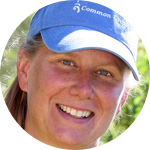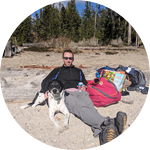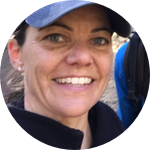About This Project
American beavers are increasingly being recognized as beneficial for riverine habitat restoration due to their dam building activities, and there is growing interest in translocating beavers for such purposes. However, with translocation also comes the risk of moving aquatic invasive species as well as fish, amphibian, and reptile diseases. In this project we seek to evaluate the effectiveness of a quarantine protocol for beaver translocation.
Ask the Scientists
Join The DiscussionWhat is the context of this research?
American beavers famously build wooden dams in streams and ponds. While their activities are considered a nuisance in some areas, beavers are increasingly being recognized as very beneficial for riverine habitat restoration. There is a growing interest in moving “nuisance beavers” into areas with habitat restoration projects. However, when translocating beavers may be a risk for accidental movement of Aquatic Invasive Species (AIS) such as New Zealand mudsnails and Asian clams as well as whirling disease, chytridiomycosis, and ranaviruses. The AIS and diseases can have negative impacts on native fauna and cause high mortalities in amphibians, reptiles, or fish populations.
What is the significance of this project?
As the interest in beaver translocation grows, there is an urgent need for establishing effective quarantine protocols that can reduce the risk of moving AIS and diseases. The Utah Division of Wildlife restricts translocations, and has established a quarantine protocol that includes holding beavers in pens with a freshwater pool that is emptied daily. The combination of repeatedly rinsing the beaver in clean water, as well as holding the animal long enough for the gastrointestinal tract to empty, is thought to reduce the risk of moving harmful organisms. However, this protocol needs to be evaluated for its effectiveness. The information gained from such an evaluation will be beneficial for future beaver translocations in North America and beyond.
What are the goals of the project?
The goal of this study is to evaluate the effectiveness of an existing quarantine protocol for beaver translocation in preventing the spread of AIS, whirling disease, chytridiomycosis, and ranavirus.
Specific objectives include:
1) Determine the presence or absence of New Zealand mudsnails, Asian clams, and Myxobolus cerebralis (whirling disease) in serial water samples filtered from the beaver quarantine pools in the beginning, middle, and end of the quarantine period. Samples will be examined via microscopy and PCR.
2) Evaluate whether beavers carry chytridiomycosis and ranavirus on their skin. All beavers undergo a health examination before translocation. Swabs will be taken from the beavers feet at this time. Samples will be tested via PCR.
Budget
This project will be conducted in association with already planned beaver trapping and translocation efforts. Funds from this grant will enable us to obtain pilot data for evaluating the effectiveness of a quarantine protocol aimed at preventing the movement of aquatic invasive species and diseases. All the funds from this grant will be allocated towards diagnostic testing of water samples for New Zealand mud snails and Asian clams ($133 per sample), Myxobolus cerebralis (whirling disease, $90 per sample), and skin swabs for chytridiomycosis and ranavirus ($20 each per sample). Trapping, quarantine, sampling supplies, and personnel cost are covered through other funding sources.
Endorsed by
 Project Timeline
Project Timeline
June – September 2019: Beaver trapping and quarantine (this activity will take place regardless of this grant). Filtering of water for AIS analysis, collection of swabs for chytrid fungus and ranavirus analysis.
October - December 2019: Laboratory analysis of samples collected during the summer. The funding from this grant will be used for testing samples.
January – April 2020: Analysis of results.
April - May 2020: Finalize a project report and manuscript.
Jun 03, 2019
Project Launched
Sep 30, 2019
Collection of samples during already planned beaver trapping
Dec 31, 2019
Analysis of water samples and swabs completed
Apr 30, 2020
Data analysis
May 31, 2020
Finalize a project report and manuscript
Meet the Team
Affiliates
Affiliates
Affiliates
Team Bio
The team members from the Utah Division of Wildlife Resources and Utah State University have extensive experience in wildlife health and biology, AIS, habitat management, and fisheries.
Annette Roug
I am the wildlife veterinarian for the Utah Division of Wildlife Resources where I oversee the State's Wildlife Health Program. I hold a veterinary degree from the School of Veterinary Medicine in Hannover, Germany, as well as a Masters of Preventive Veterinary Medicine and PhD in wildlife epidemiology from the University of California Davis, USA. My PhD research mainly focused on the health and ecology of African buffaloes in Ruaha National Park, Tanzania and the epidemiology of bovine tuberculosis and brucellosis at the wildlife, livestock, and human interface in communities adjacent to the park. Since moving to Utah, I have predominantly conducted research within the fields of wildlife health and wildlife capture, and started working with beavers in 2017 when assisting biologists with placing radio tracking devices. Since then, I have learned more about the incredible benefits that beavers can have for riverine habitats, and am excited about the option of moving nuisance beavers in place of other alternatives. However, animal translocation needs to be conducted responsibly without the risk of moving harmful pests and pathogens, and beaver translocation is no different. As more and more wildlife and habitat managers are becoming aware of the benefits beavers can provide, the need for a scientifically sound beaver translocation protocol is increasing. We are trying to fill this need with the proposed project.
Phaedra Budy
I am a Professor in the Department of Watershed Sciences and Unit Leader of the Utah Cooperative Fish and Wildlife Research Unit (U.S. Geological Survey), at Utah State University (USU), Logan UT. I completed a B.S. in Limnology at the University of California, Davis and a PhD at Utah State University in aquatic ecology, investigating the potential to increase growth and survival of endangered sockeye salmon in the Sawtooth Mountains of Idaho, using whole lake manipulations. I then completed a post-doctoral fellowship at the the Luquillo Long Term Ecological Research site in Puerto Rico, exploring amphidromous shrimp population structure and genetics.
In my fish ecology lab, along with my graduate students and staff, I do research that fits into an overall framework of evaluating the factors that structure and limit fish populations in both lentic and lotic systems. We work broadly in conservation biology, invasion ecology, and food web dynamics of aquatic systems with an emphasis on fishes. Current research covers a wide geographical range including almost all of Utah, Oregon, Washington and arctic Alaska and includes many species of salmonids, imperiled native desert fishes, and numerous warm-water lentic fishes. We also dabble in stream restoration and large river management. I am particularly interested in desert fish conservation and ecology, as these fishes are highly imperiled and their ecosystems are degraded in multiple complex and interacting ways. More information describing the Fish Ecology Lab at USU is available at: www.usu.edu/fel.
Wade Cavender
I am currently working for the Utah Division of Wildlife as the Assistant Aquatic Section Chief in charge of fish health and fisheries research. Specific responsibilities include serving as Utah’s primary Fish Pathologist and program manager for Utah’s Fisheries Experiment Station (FES). Station activities include providing a comprehensive program for fish pathology, aquatic research and fish culture services in relation to the Aquatic Section Statewide objectives and fisheries program needs. I also work as a member of the Aquatic Section administrative staff, Fish Health Policy Board and Western Regional Aquaculture Center to advise in the development of policies and procedures relative to fish health, fish culture and fisheries management throughout the State. Prior to this assignment I served as the Fish Health Specialist and laboratory manager for the State’s fish health laboratory from 2005-2016. I received my A.S. in Fish and Wildlife Management (1994) from Hocking College, B.S. in Fisheries Management/Aquaculture (1999) from the University of Idaho and M.S. in Fish Health/Aquaculture (2003) from the University of Idaho.
Nathan Owens
I have served as the Utah Division of Wildlife Resources' Aquatic Invasive Species Coordinator for the past three years, helping to develop the largest invasive mussel containment program in the country. I graduated from the University of Washington's Zoology Program and received my graduate degree from the University of Montana, where I studied human/wildlife interactions in eastern Europe.
Darren DeBloois
I am an experienced wildlife biologist and currently serve as the Mammals Program coordinator for the Utah Division of Wildlife Resources. This program oversees issues relating to a variety of mammal species including beavers.
Julie Young
I am a research scientist for the USDA and Associate Professor at Utah State University. I received my B.S. degrees at Texas A&M University, a M.S. at Iowa State University, and a Ph.D. at Utah State University. I held postdoc positions with Arizona State University and Wildlife Conservation Society. I am now the project and field station leader for the Predator Research Facility. My research focuses on behavior, ecology, and management of carnivores and their prey. I utilize wild and captive carnivore populations to understand and reduce human-wildlife conflict.
Nate Norman
I have over 25 years of practical experience in wetland creation and stream restoration as an environmental consultant and have recently turned my direction to beaver translocation and restoration. I have been working with the team USU’s Fluvial Habitats Center, and I am currently the lead trapper and husbandry researcher for USU’s beaver translocation efforts. I graduated from Eastern Michigan University with a degree in aquatic biology.
Heather Talley
I have worked for the Utah Division of Wildlife Resources for ten years. I began beaver translocations via Habitat Council funding in 2012, and has moved a total of 147 beavers. This project has fomented riparian ecosystems at release sites, and has improved relationships with private landowners by alleviating nuisance issues. I have worked with other sections within the agency, federal agencies, political entities, and other constituents to make this project possible. We have started utilizing VHF transmitters on trapped beavers, and hope to gain information pertinent to creating the most optimal conditions for translocation success.
Lab Notes
Nothing posted yet.
Project Backers
- 19Backers
- 13%Funded
- $642Total Donations
- $33.79Average Donation









